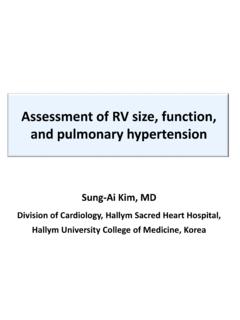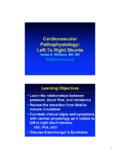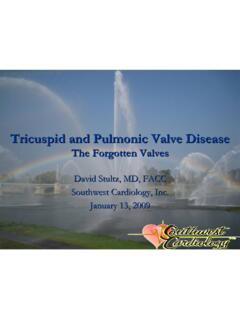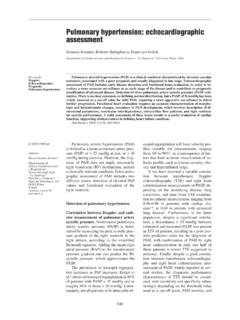Transcription of Pulmonary Artery HTN PULMONARY PHYSIOLOGY Diagnosis
1 PULMONARY Artery HTN PULMONARY PHYSIOLOGY . Diagnosis Akram Khan, MD. Assistant Professor PULMONARY And Critical Care Medicine Pre-capillary Capillary Post-capillary From Systemic Lungs Circulation Pre-capillary Systemic RV LV. VC RA PA PV LA A. Circulation Post-capillary PULMONARY Hypertension = abnormally high From Systemic pressure in the PULMONARY arteries Circulation Post-capillary PH. Cor Pulmonale Valvular Heart disease PULMONARY Arterial Lung disease Systolic dysfunction Hypertension Sleep apnea Diastolic dysfunction Pre-capillary disease Thromboembolic Veno-occlusive disease disease Pericarditis Pre-capillary VC RA RV PA PV LA LV A VC RA RV PA PV LA LV A. Post-capillary PULMONARY Hypertension = abnormally high PULMONARY Arterial Hypertension = abnormally high pressure in the PULMONARY arteries pressure confined to the pre-capillary vessels 1. Clinical Classification of PULMONARY Hypertension 2008 Dana Point PULMONARY Artery Hypertension PH with L heart disease PH associated with lung diseases and/or hypoxia Chronic Thromboembolic PH (CTEPH).
2 EPIDEMIOLOGY Multifactorial / Misc. & PATHOPHYSIOLOGY. Publication pending. Pathogenesis Risk Factor + Vascular Disease Susceptibility Injury Progression Gaine, S. JAMA 2000;284:3160-3168. PULMONARY Capillaries Collapsed capillaries Normal capillaries Pulm Artery Pressure Pulm Blood Flow Recruitment Distension 2. Idiopathic PAH (iPAH) Survival in Current Era: Comparison with Rapid Progression and Poor Survival NIH Historical Controls 100. 100 100. 91. 80 90. 80 76 Observed 67. al (%). 70. val (%). 65. 60 60. Surviva 68%. Surviv 50 43. 40 40 32. 48% 30. Predicted (NIH). 34% 20. 20 10. 0. Baseline 1 year 3 year 5 year 0. 0 1 2 3 4 5. Years of follow-up N=194. D'Alonzo GE et al. Ann Intern Med .1991;115:343-349. Thennapan T, et al. Chest. 2007;132(4 suppl):487S. Prevalence of PAH: French National Registry Prevalence of PAH: French National Registry Consecutive adult patients Time interval b/w symptom onset and Diagnosis : 27 months 18 years of age Mean age ~ 50yrs 17 French specialty centers Twice as many women as men B/W Oct 2002 - Oct 2003.
3 Prevalence of PAH: cases/million Prevalence of iPAH: cases/million Humbert M et al. Am J Respir Crit Care Med. 2006;173:1023-1030. Humbert M et al. Am J Respir Crit Care Med. 2006;173:1023-1030. REVEAL: REVEAL: Symptoms at Diagnosis Database Characteristics Dyspnea at rest 11% APAH IPAH. 11%. 50-center US database 13%. Cough n = 1479. Median time from initial symptoms to RHC Dizzy/lightheaded 14%. 14 months Presyncope/syncope 20%. Median time from to first visit to p PULMONARY y hypertension yp Edema 20%. clinic IPAH APAH Chest pain/discomfort 15 months (n = 685) (n = 760) 20%. 23%. Average body mass index Female-to-male :1 :1 27%. ratio Other + kg/m2. Fatigue 29%. Mean age at 45-54 45-54 Diagnosis (years) Dyspnea on exertion 83%. 0 25 50 75 100. Incidence (%). Badesh DB, et al. Chest. 2007;132(4 suppl):473S. Elliott EG, et al. Chest. 2007;132(4 suppl):631S. 3. PAH Associated With PAH Associated With Scleroderma Connective Tissue Diseases (CTD). 100 Prevalence: 10-15%. Perrcent survival 80.
4 33% Systemic sclerosis No lung involvement (n=138) 50% CREST. 60 Overestimate: lack of RHC confirmation 40 Lung involvement without PAH Systemic sclerosis: 75% of PAH associated with CTD. (n=73). 20. Rapidly progressive PAH disease course PAH (n=17). 1-year survival: 45% to 69%. 0. 0 1 2 3 4 5 6 7 8 9 10 11 12 13. Years from Diagnosis of PULMONARY hypertension Coghlan JG et al. Lupus. 2006;15:138-142. Mukerjee D et al. Ann Rheum Dis. 2003;62:1088-1093. Kawut SM et al. Chest. 2003;123:344-350. Braunwald E, Zipes BP, Lippy P, eds. Heart Disease. 2 vols. 6th ed. Philadelphia, PA: WB Saunders Koh ET et al. Br J Rheumatol. 1996;35:989-993 CO;2001:170,173, 372, 499, 1908, 1912, 1918-1921. PAH Associated with PAH Associated with HIV. Congenital Heart Disease (CHD). ~ M Americans have congenital heart defect PAH occurs in 1 in 200 patients with HIV infection 6 cases/1000 in general population PAH a significant mortality factor when present cases/million of PAH associated with CHD in adults With improved outcomes due to highly active antiretroviral Eisenmenger syndrome more common with large defects therapy (HAART).
5 Almost all cases of truncus arteriosus Near N complete l t normalization li ti off pressures with ith vasodilator dil t therapy 50% with large VSD. 10% with large ASD. Marelli AJ et al. Circulation. 2007;115:163-172. Gali N et al. Drugs. 2008;68:1049-1066. The Opravil M et al. Am J Respir Crit Care Med. 1997;155:990-995. Task Force on Diagnosis and Treatment of PULMONARY Arterial Hypertension of the European Speich R et al. Chest. 1991;100:1268-1271. Society of Cardiology. Eur Heart J. 2004;25:2243-2278. Nunes H et al. Am J Respir Crit Care Med. 2003;167:1433 -1439. Methamphetamine Use as a Risk Factor for PAH*. PAH Progression 40. Presymptomatic/ Symptomatic/ Declining/. Compensated Decompensating Decompensated nts %. 30. Patien 20. CO. Symptom 10. Threshold PAP Right Heart Dysfunction 0 PVR. Idiopathic Other PAH Thromboembolic PH RAP. Time *Retrospective analysis at single PH center of adults with PH. CO=cardiac output; PAP= PULMONARY arterial pressure; PVR= PULMONARY vascular resistance.
6 Chin KM et al. Chest. 2006;130:1657-1663 RAP=right atrial pressure. 4. Diagnostic Approach to PAH. JACC Vol. 54, No. 1, Suppl S, 2009 Proceedings of the 4th World Symposium on PH. Echocardiography Severity of PULMONARY Hypertension Degree of Disease Mean PULMONARY Artery Systolic Pressure (mm Hg) Cath PULMONARY Artery Pressure (mm Hg) echo Mild 25-50 40-60. Moderate 41-55 60-80. Severe >55 >80. Right Heart Catheterization Required to Confirm Diagnosis Calculate PVR. Guide therapy for PAH. Exclude other etiologies for PH. Intracardiac or extracardiac shunts Left-heart disease McGoon M. Chest. 2004;126:14S-34S. 5. Right Heart Catheterization Measure degree of right-heart dysfunction Right atrial pressure Cardiac output Vasodilator testing McGoon M. Chest. 2004;126:14S-34S. Normal PULMONARY Hemodynamic Values Definition of PAH by Right Heart Catheterization Normal PULMONARY Hemodynamic Values Cardiac Output (liters/min) 4-6 Increased mean 25 mm Hg at rest, or Right atrial pressure (mmHg) 2-8 PULMONARY arterial 30 mm Hg during exercise PULMONARY Artery pressure (mm Hg) pressure (mPAP).
7 S t li Systolic 16 24. 16-24. Diastolic 5-12. Mean 9-16. PULMONARY wedge pressure (mm Hg) 5-12 Normal PULMONARY PULMONARY vascular resistance capillary wedge 15 mm Hg (dynes/sec/cm-5) 80-160 pressure (PCWP). Increased PULMONARY >3 woods units vascular resistance (PVR). Rubin LJ. Chest. 1993;104:236-250. Severity of PULMONARY Hypertension PAH Diagnostic Workup Echocardiography suggests PH. Degree of Disease Mean PULMONARY Systolic PULMONARY Artery Pressure (mm Artery Pressure Hg) echo (mm Hg) Cath 6 minute walk & Functional class Right heart Mild 25-50. 25 50 40-60. Borg score catheterization Moderate 41-55 60-80. Severe >55 >80 Establish baseline, prognosis and document progression/response to Confirm Diagnosis treatment with serial re-assessment PAH. McGoon M. Chest. 2004;126:14S-34S. 6. Case Presentation: History Case Presentation: History 52 year old male 2 syncopal episodes, both while walking at a 7 month h/o progressively worsening dyspnea brisk pace Walking slowly causes immediate severe No cough, chest pain, or wheezing dyspnea & dizziness (WHO III) No N other th significant i ifi t medical di l hi history t Symptoms subside at rest Takes no medications Clinical Problem 1 Clinical Problem 1.
8 Physical exam Physical exam Temp 37C Fixed splitting of the S2. BP 105/60, Increased pulmonic component Pulse 102 at rest and 120 after walking walking, Grade 11-2/6. 2/6 holosystolic murmur at left sternal RR 20/min border near the fourth rib that increases with BMI 32 kg/m2. inspiration Jugular venous distention + Lower extremity edema, No cyanosis or clubbing Lungs: Clear to auscultation with no wheezes or crackles Clinical Problem 1 Clinical Problem 1. Diagnostic Data Which of the following is the best next step in the CBC (polycythemia vera can lead to PAH) and evaluation of this patient? resting ABG are normal A. Bronchoscopy and trans-bronchial lung biopsy ECG rightward QRS axis and large R waves in V1 Interstitial Lung Disease Spirometry & plethysmography are normal B. Methacholine challenge test Chest radiograph shows no infiltrates or masses Asthma C. Right-heart catheterization & PULMONARY angiography PULMONARY Hypertension D. Trans-thoracic echocardiography PULMONARY Hypertension 7.
9 Clinical Problem 1 Goals of Management of PAH. ANSWER: D Improve survival Transthoracic echocardiography Prevent worsening In patients with suspected PULMONARY HTN Improve hemodynamics TTE can suggestt the th presence off pulm l HTN Maintain or improve functional class Evaluate for cardiac causes of elevated pulm Artery Improve exercise capacity pressure Improve daily functioning and quality of life Considerations for Considerations for Selecting Initial Therapy for PAH Selecting Initial Therapy for PAH. Severity of symptoms 6-minute walk distance Physical examination (right-heart failure?) BNP/NT-pro-BNP. Rate of progression Capability of patient to handle parenteral therapy Echocardiogram (RV size and function). Right heart catheterization Mean PA pressure and cardiac index Considerations for Cost Analysis Selecting Initial Therapy for PAH. Parenteral therapy is first choice in very advanced Approximate annual cost patients Sildenafil $12 761. Other issues Bosentan $55 890. Drug-drug interactions Ambrisentan $56 736.
10 Adverse events Iloprost $92 146. Comorbid conditions (eg, diabetes) Based on a 70-kg patient at the lower end of the dosing Route of administration spectrum Dosing intervals Epoprostenol $33 153. Cost Treprostinil $97 615. Journal of the American College of Cardiology Volume 53, Issue 17, 28 April 2009, Pages 1573-1619. 8. Questions PAH Determinants of Risk Lower Risk Determinants of Risk Higher Risk Clinical evidence of No Yes RV failure Gradual Progression Rapid II III. II, WHO class IV. Longer (>400 m) 6MW distance Shorter (<300 m). Minimally elevated BNP Very elevated Pericardial effusion, Minimal RV dysfunction Echocardiographic findings significant RV dysfunction Normal/near normal Hemodynamics High RAP, low CI. RAP and CI. McLaughlin VV, McGoon MD. Circulation. 2006;114:1417-1431. 9.










